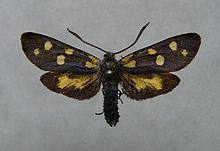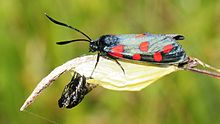Horseshoe ram
| Horseshoe ram | ||||||||||||
|---|---|---|---|---|---|---|---|---|---|---|---|---|

Horseshoe ram ( Zygaena transalpina ) |
||||||||||||
| Systematics | ||||||||||||
|
||||||||||||
| Scientific name | ||||||||||||
| Zygaena transalpina | ||||||||||||
| ( Esper , 1780) |
The horseshoe clover ram ( Zygaena transalpina ) is a butterfly ( moth ) from the ram family (Zygaenidae).
features
The moths reach a wingspan of about 30 millimeters. They have black forewings with six red spots that are small and further apart than those of the six-spot ram ( Zygaena filipendulae ). On the underside of the wing, these grow together more or less. The hind wings are red and have a black border on the outer edge. The ssp.tilaventa moths are also yellow in color. The antennae are club-shaped and thickened and brownish to yellowish in color at the tip.
The caterpillars are approx. 20 millimeters long and have a yellow-green basic color. They have two black dots along the sides of the back on each segment and a thin black longitudinal line on the side of the body. There is a yellow vertical stripe between these two lines. There is also a fine black line on the back, but this is missing in some animals.
Similar species
- Six-spot ram ( Zygaena filipendulae )
- Horn clover ram ( Zygaena lonicerae )
- Marsh horn clover ram ( Zygaena trifolii )
- Little pentagonal ram ( Zygaena viciae )
- Elegans ram ( Zygaena angelicae )
Subspecies
The following subspecies are known in Europe:
|
|
|
Occurrence
This species can be found in warm places in the Alps up to over 2,000 meters above sea level and in the southern German mountainous region and generally in and generously around the Alps, in the Italian pre-Alps, throughout Italy, with the exception of Sicily and the Adriatic coast . They live in dry and warm areas, especially on dry grassland but also on meadows rich in flowers, higher up. They are not common.
Way of life
The horseshoe clover rams, in contrast to the six-spot rams, sit with spread wings on the flowers when sucking nectar. The females usually lay their eggs in mirrors on the underside of the leaves of the forage plants. The caterpillars sometimes live in community. They overwinter and pupate only in June of the next year in an elongated, yellowish cocoon on stems and blades.
The caterpillars feed on the leaves of the ordinary horseshoe vetch ( Hippocrepis comosa rare), but also by Colorful crown vetch ( Coronilla varia ) or the ordinary foot trefoil ( Lotus corniculatus ).
Flight and caterpillar times
The moths fly in one generation from late May to August. The caterpillars are found from August and after wintering until June of the following year.
Hazard and protection
- Red list FRG: 3 (endangered).
swell
Individual evidence
- ↑ Burchard Alberti: On the question of the hybridization between Zygaena angelicae O. and transalpina Esp. (Lep. Zygaenidae.) . Journal of the Vienna Entomological Society, 41st year (1956), p. 231, online (PDF; 1.0 MB).
- ↑ Zygaena transalpina in Fauna Europaea. Retrieved March 14, 2011
- ↑ Phylogeography of the Zygaena anglicae / transalpina Complex. (No longer available online.) Björn M. von Reumont, archived from the original on September 25, 2011 ; Retrieved March 14, 2011 . Info: The archive link was inserted automatically and has not yet been checked. Please check the original and archive link according to the instructions and then remove this notice.
- ↑ Manfred Koch : We identify butterflies. Volume 2: Bears, Spinners, Swarmers and Drills in Germany. 2nd, expanded edition. Neumann, Radebeul / Berlin 1964, DNB 452481929 , p. 62.
- ↑ Federal Agency for Nature Conservation (Ed.): Red List of Endangered Animals in Germany . Landwirtschaftsverlag, Münster 1998, ISBN 3-89624-110-9 .
literature
- Heiko Bellmann : The new Kosmos butterfly guide, butterflies, caterpillars and forage plants . Franckh-Kosmos, Stuttgart 2003, ISBN 3-440-09330-1 .
- Günter Ebert: The butterflies of Baden-Württemberg . 1st edition. tape 3 . Moths I. Root borer (Hepialidae), wood borer (Cossidae), ram (Zygaenidae), snail moth (Limacodidae), sack bearer (Psychidae), window stain (Thyrididae) . Ulmer, Stuttgart (Hohenheim) 1994, ISBN 3-8001-3472-1 .
- Hans-Josef Weidemann, Jochen Köhler: Moths, Spinners and Swarmers . Naturbuch-Verlag, Augsburg 1996, ISBN 3-89440-128-1 .


